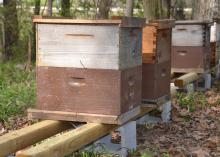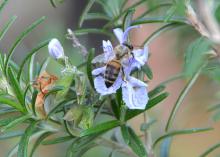Information Possibly Outdated
The information presented on this page was originally released on March 18, 2016. It may not be outdated, but please search our site for more current information. If you plan to quote or reference this information in a publication, please check with the Extension specialist or author before proceeding.
Beekeeping hobby grows in Mississippi, nation
RAYMOND, Miss. -- Beekeeping is hot right now, with numbers of producers steadily increasing in Mississippi and across the U.S.
“Beekeeping continues to grow in astonishing numbers across the country,” said Jeff Harris, bee specialist with the Mississippi State University Extension Service. “Most of that growth is from people who want to do it as a hobby.”
Johnny Thompson, a Philadelphia, Mississippi, beekeeper who raises queens and nucleus colonies, said about half of his customers are new to beekeeping.
“Most are hobbyists,” he said. “A lot of people are reading about how bees are disappearing and want a hive. Some people have gardens and say they never see any bees.”
Thompson, who also sells honey, said he is sold out of queens and nucleus colonies through early May. Nucleus colonies, or “nucs,” are smaller colonies with food, a laying queen and worker bees in all stages of development. When placed in a larger box, the nuc grows rapidly into a full colony.
“I can’t produce enough queens to meet the demand,” Thompson said. “We have doubled our production every year for the last few years, and we still can’t keep up. We’re making up nucs now. We did 150 this week and will do 100 next week. Every year I keep thinking it will slow down, but it never does.”
In 2015, about 1,000 Mississippi beekeepers managed between 20,000 and 25,000 hives. Approximately 30 of those beekeepers are commercial producers who earn a large portion of their annual incomes from beekeeping. The remaining beekeepers are small-scale producers or hobbyists, Harris said.
With an average yield of 100 pounds of honey per colony, Mississippi leads the nation in honey production. In 2015, honey sold on the wholesale market for $2.15 per pound and had a total value of between $4 million and $5 million.
Mild winters and abundant plant life, including wildflowers and row crops, make Mississippi an ideal place to raise honeybees. Producers who rotate their bees throughout the state can produce honey during three seasons of the year.
About 15 beekeepers from Northern and Midwestern states overwinter their bees in Mississippi because the bees are less stressed and food is available earlier in the spring.
“These large commercial beekeepers can bring 8,000 colonies of bees here for the winter,” Harris said. “As the bees begin to grow, they can split their existing hives and double their numbers of colonies, returning home with 16,000 colonies for summer honey production.”
Harris said he does not expect unusually high levels of winter mortality in Mississippi this year. However, Varroa mites and small hive beetles are the biggest challenges for Mississippi beekeepers every year. Varroa mites spread viral diseases that can cause high summer or winter losses of bees, depending on when mite populations swell in the hives.
“Lots of people think that a dead colony without any bees found inside is a mysterious death, but more often than not, it can be related to a failure to control Varroa mites,” Harris said.
Small hive beetles invade weak or dying colonies and lay their eggs on honeycombs. Their larva tunnel through the comb and eat the developing bee brood, honey and pollen. Adult bees are repelled by the slime left behind by the larvae and will abandon the hive, Harris said.
“Strong colonies can handle the beetles,” he said. “Removing weak colonies and keeping honey houses clean from comb debris are the only real ways to combat this pest. If people are good at managing Varroa mites, they have more than managed half the battle against small hive beetles.”
Homeowners can also support Mississippi’s bee population by strictly following label directions on garden chemicals, such as insecticides, fungicides and herbicides, Harris said.
“If a flowering plant is in bloom, and pollinators are visiting it, it is best not to apply an insecticide or to apply it as late in the day as possible,” he said. “Most honeybee flight activity to get food occurs between 10 a.m. and 2 p.m. If you wait until late evening, most foraging honeybees are no longer visiting plants and the risk of exposure to the insecticide is greatly reduced. Most insecticides break down within eight hours or so, and the residues are all but gone by the time the sun rises the next morning.”
Another option is to use a chemical-free product, such as an insecticidal soap or Neem oil.





